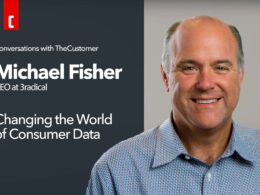Ron Shamah, CEO of Rightpoint, walks us through the intricate connections between employee experience, customer experience, and product experience. This episode unravels these intriguing interconnections and how they’ve put a unique pressure on organizations. We bring you a candid discussion on how businesses can reimagine customer experience and tackle seemingly insurmountable challenges with the aid of Rightpoint.
Ready for a glimpse into the future of work? In this engaging episode, we tackle the complexities of AI, the growing confidence of C-suite leaders, and the tools necessary for a fulfilling work experience. We also delve into the challenges that executives face when trying to measure high performance in a hybrid or remote environment. Get ready to navigate the labyrinth of employee experience infrastructure and ecosystem, and learn how to use these tools to your advantage.
Full transcript of this episode below
Ron Shamah
CEOs have never had a lower confidence interval that they have a finger on the pulse of their organization, that they know where the risk lies, that they know where the opportunity lies.
And so I think this frame on employee experience, I’d say it’s the hotspot, if you will, in the continuum, in the ecosystem of CX and product experience. If you dissect different facets of the continuum or ecosystem that we plan, there’s a lot of work, a lot of good work being done. But if you take a holistic frame and a bit of a step back, I think we’ll see lots of holes today in how different organizations are solving for the connective tissue that brings this together. And even in your brief opening, mike, the employee experience angle, I think, has put a really unique pressure test on a much more long-standing and long-tenure frame in customer experience. Right, everybody is knowing the customer has been important for a really long time since wheels were square. But the employee frame, I think COVID and some of the aftermath and this hybrid work environment that we’re in from executives that I talked to, led by the client landscape CEOs have never had a lower confidence interval that they have a finger on the pulse of their organization, that they know where the risk lies, that they know where the opportunity lies.
And so I think this frame on employee experience, I’d say it’s the hotspot, if you will, in the continuum, in the ecosystem of CX and product experience. But I have, I’d say, a student and that there’s hopefully real humility that comes with that, because I am humbled by coming up the learning curve while I’ve been involved with, in particular, cx for the better part of 25 years. It’s a different frame when you’re looking at the connected tissue but between these disparate connection points. So a little bit on me and excited for the discussion.
Mike Giambattista
Oh, thanks. I mean you’ve summarized kind of the basic perspective that we’ve built and publish around and been doing so over the past four or five years three, four years, something like that. But it was interesting that EX this is from my perspective and it’s granted it’s a sidelines perspective EX was almost a token topic to be addressed, if you will say three years ago. It was something people recognized, they needed to acknowledge but weren’t ready to. I think Talking to the enterprises that I talked to it was a great thing. And then COVID hit and it became the topic.
Ron Shamah
That’s right.
Mike Giambattista
It just became, you know, followed by a whole list of expletives that indicated they should have been dealing with this a long time ago. But I’ve spoken to essentially everybody I speak with in the CX world now is thinking about their efforts in terms of CX and EX. The unique thing I find about your offering is that you’re fusing that with product experience as well, and that takes a whole different set of disciplines. That’s not something that, frankly, I don’t think anybody else is thinking about in the folks that I speak with. So I would love to talk about from your perspective, which is an elevated perspective. You sit at what I would call the pinnacle of, certainly near the pinnacle of that world and have a perspective on probably broader trends than most people do.
By virtue of that, I would love to just get your thoughts on, even from the most basic how do enterprises start to think about CX in a modern way? Yeah, because there’s a lot that goes into it, a lot of cultural change and change management and all that stuff. But how do modern enterprises start to think about modern CX fusing in EX? What are those hurdles? How are they overcome? How does right point help and solve those problems and then layering in the whole product experience angle as well, which may not even sound like a question. I think I basically just dumped the whole thing on you. Yeah, that’s all good. Please unpack and clarify.
Ron Shamah
Yeah, I appreciate that and I love the opportunity to dissect it in this holistic frame Again, the we call total experience. I’ll take it from a little bit of, I’d say, as we opened some of the more at least known commodities on the surface. I do think that starts with CX, because I think, from an unaided awareness standpoint, before data starts to be unfolded, I feel like most leaders would say they have a good finger on the pulse of what’s happening with their customers. I think you and I would probably challenge that a bit because of the complications of the environment and the ecosystem around it. And then there’s this whole other frame that I’d love to save some good time for on the measurement of it, and that measurement becomes even more complicated as you start to unpack the facets of customer experience, employee experience and product experience and this kind of ecosystem the we call total experience. So if we’re going to go inside out, then maybe even starting with the employee frame is the best way to do it, because there’s one quote that I have fallen in love with really coming through and graduating from the COVID experience, as you nodded to, which I think was a real catalyst to get leaders to pay attention to employee experience and that quote was the fastest way to get customers to love your brand is to get employees to love their jobs. Again, lots of the territory that we’ll cover might simple on a read. I don’t think anyone will disagree with that, and that was by Tiffany Bova.
She’s the author of the experience mindset. I’ve had the opportunity to engage with her. I think she sees things very clearly. I’d like to think I’m a practitioner in what Right Point does to enable and enact and implement much of the mindset and strategy that she talks about. For that matter, Gartner, preeminent, not only advisor but obviously analyst. They’ve spent a bunch of time on their own frame on total experience.
I think you have a lot of folks circling the right territories. But I like this inside-outside perspective which has this thought in my mind with employees and we nodded it to it a little bit on the opening. But I think the easiest conversation to strike a chord with today is AI. I think that there’s still so much to be figured out there, led by some standardization, but that’s the easiest discussion that I can see in the C-suite today because there’s a significant complex associated with it. I’d say that’s closely followed by asking any executive their confidence interval, that they are endearing themselves to their employee base, that their employee base has the tools and connections today that they can have a fulfilling experience. I think that’s where everything starts to break down from a complex standpoint.
Mike Giambattista
I’d be interested to know if you have some sort of a mental index of how those C-suite leaders are processing, like what is their confidence level across the board? If there is some sort of a, you know, I think overall they’re at 50-50 or you know, maybe they generally have a how do you what’s your gut? Read on that.
Ron Shamah
My gut read is upwards of 80% of the C-suite that I speak to lack a significant and appropriate confidence interval that they have the right employee experience, infrastructure and ecosystem in place for their organizations.
Mike Giambattista
It’s a big number. It’s a big number. On the one hand, it’s a scary number, but on the other hand, it’s a huge opportunity for jumping out of the curve.
Ron Shamah
Yep, and I think you know one way to test that. I think if you ask on the blink, maybe that number would be less intimidating than the 80%. But when you start asking questions about well, how do you judge especially for organizations of scale, I’ll use maybe the business that I know best in professional services when do you look at high performance? Very often you’ll hear utilization reports, but I struggle to think there’s a lot of factors, including fortune, to go into play as to how people get staffed to certain projects. I struggle to think that a utilization report is going to tell you the rising stars of an organization.
You and I, just judging by the color of our hair, have been in this line of work for a while and I think about how we showed hustle, how we showed grit as we grew up in corporate America and how we, for the longest period of time to your frame, up until three, four years ago how we would judge that showing of hustle, that showing of grit. And I’ll take it back for me very personally to first job. Nine days out of college I started at Citibank. Of course I had no idea what I was doing, but I wanted to show and I wanted to impress that this scrappy, undersized kid from Staten Island was going to hustle. So I made a commitment to myself that I was going to put the lights on in the morning and I was going to shut the lights off when I left, and I had hoped that that would yield a proxy that I could that while I was still trying to figure out the difference between a savings account, that there was this proxy for hustle and the investment I was willing to make. Well, again, take that back to an executive conversation like how can you see, in a hybrid environment, in some cases fully remote environment, where’s the confidence interval of an executive that they know that tenacity, with that grit, with that hustle, lies in their organization? Conversations break down all the time on that because they can’t see it, because there’s not the ubiquitous water cooler that Mike and Ron had to be able to show for ourselves growing up in a space and to observe as we became leaders. So again back to the 80% number.
Folks may be taken aback, but as you start to probe on where, I went a little bit with the like what do you use to measure utilization, reports and professional services?
Not going to tell you that and it puts so much pressure through digital channels, and though teams and Zoom and lots of other forms have come a long way, I think it lacks its ability to touch on, you know, all five of the senses and to really give an executive an ability to do that.
So that puts the pressure on what is the digital tool set that can have an infrastructure effect to serve as a proxy on how your employees are feeling? And then, what are you doing to be able to create a corrective action plan in a segmented way, ideally, where you would have a different treatment based on the roles, the responsibilities, even the DNA of your population and, as we know, young millennials and Gen Z are going to react, you know, very differently to someone in a more mature part of the workforce and too often there’s, you know, catch all buckets that are there. The more questions you ask, in my experience, to the C-suite about how they’re currently managing and leading through employee experience in this new normal, the more you’ll see that number grow with a lack of confidence.
Mike Giambattista
I mean you related. I completely share your perspective. Mine again is from the sidelines. You’re deep in the middle of it, but you related that kind of through a lens of how we all operate in the digital world now and we don’t have the face to face nuances of you know all the interactions that we used to have and that makes it much more difficult. But I don’t know and I’d love your perspective on this that even if this was a face to face world, like it used to be, measuring things like sentiment and grit and where effectiveness lies in a workspace is just plain difficult. I mean, coming up with those tools is we cry or some real thinking? How does, how, does right point address those without giving away any kind of secret sauce?
Ron Shamah
No, I’d say that there’s an advisory frame right, that that almost always starts as a consultancy, will do a deep dive to understand the. I’d say it starts with a bit of a confidence interval because I think that can be very telling. It often will not be where we end up after we leave some what I’ll call discovery workshop to understand. How does the sentiment of the leadership, which is always a strong place to start, how does that match the entire organization? Often, again, until probe, confidence levels can be higher in spots, but when the real probing starts and the real discovery, a lot can fall down on that. So I think that there’s this advisory frame that can start to map current objectives against current initiatives and data, as always, will play a huge role. To your point in the sentiment analysis, I think, where I went with the conversation, that there is a subjective frame as leaders make decisions all day, every day, with an imperfect data set in front of them and as much as survey tools I think can be really, really powerful, the story that somebody tells you and the data tells you can vary from a story observed, from a story experience, and it’s difficult to account for that and scoring. So I do think that there is a that as leaders.
There’s a big tangible part of this equation, and the more we can drive towards the tangible and allow data to normalize outliers, the better will be.
But we cannot let that take away from that. There’s an intangible frame as well associated with that, and I do see big variances when I’m talking to financial services organizations, where they have had a much greater push on return to office, for instance, than to, I’d say, more digitally native companies that have had a higher degree of embracing, hybrid and in some cases, even fully remote. So I think it’s a very different approach from an advisory, from a strategy standpoint, but it has to start with some scoring across tangible and intangible measures over perception, over where they are, where they want to go, and then outlying different tracks. That will very often take the form of understanding, process tools and data in support of you have to set the goalposts before you embark on an action plan. So you know what if that scoreboard is moving? Are you key performance indicators? Are you measurable business results? Are they moving as a result of corrective action plans you’re taking? I want to take a quick break from the conversation to tell you about one of our sponsors.
What’s an Expectation Audit?
What could you achieve if you knew what your customers expected ahead of time? What if you could know what customers expect by category and by brand 12 to 18 months ahead of traditional brand tracking methods? And what if you could know exactly where to adjust and where to spend in order to derive the most benefit every time. A customer expectation audit allows you to identify areas that require strategic reinforcement, as well as pinpoint which values will contribute most to an emotional bond with your brand and optimize accordingly.
Customerland has partnered with Brand Keys, the world’s oldest loyalty focused consumer research firm, to bring real world customer expectation audits to brands, brand managers and to CX practitioners everywhere Want to know where your brand stands and exactly what to do about it.
Go to expectationaudit.com and download a sample audit today.
Ron Shamah
Yeah, it’s a really powerful frame and I think a little bit to where we open. This is where the measurement aspect of our frame on total experience has manifested itself into something we call ROTX or Return on Total Experience. As Mike, you and I know for many, many years. If you just put in Google ROX or ROE some proxy for Return on Experience you will see endless amounts of content produced by every large-scale consultancy advertising firm that’s out there on their perspective on how to measure that Return on Experience. I would challenge you or anyone to try to stay awake on slide three. I find it nearly impossible.
Mike Giambattista
I’m challenged. I’ll accept that challenge and see if I can actually do it Good luck.
Ron Shamah
It is a sea of sameness. Back to the tangible and intangible frame. Very little that’s tangible on how this measurement of experience comes through. Many clients that I’ve worked with for over two decades now will want to ladder back to a known commodity. I’ll use the example, such as an NPS score. I think there’s some flaws in the NPS methodology.
I don’t think it’s perfect, but it is a ubiquitous yardstick that gives an organization an ability to score themselves against a competitive set. Company A can be across facets that matter to them, a 6.8, and they want to get to an 8.3, and then you can have some frame on what are the activities that you have to engage on to close that gap. I think there’s a perfect no, but there is a uniformity in that yardstick that sets an action plan post-measurement. Nothing like that exists in the experience place today that I know of. That can provide that yardstick in a clear, concise way that could span industries and verticals and to give a uniform view on how to close it.
That gets further complicated. By now we’re no longer just talking about customer experience, where the whole industry, for understandable reasons, has been dominated Well off the heels of the employee experience conversation we came from and a low confidence interval by executives that they have their finger on that pulse. Then you overlay a product frame or in some cases that product may take the form of services landscape. So now you’re looking at this total experience landscape of customers, of employees, of products, and you’re trying to develop a yardstick that sits across even harder for the dated content that’s out there that tries to unpack return on experience. So the level of difficulty is on the rise.
Mike Giambattista
I’m so are. Are you suggesting that return on total experience is should become the new, the new yardstick?
Ron Shamah
I think we have work to do. I’d love to stake that claim, I think.
Mike Giambattista
And then that’s not to be coy, but I completely agree with you that there’s nothing with with that kind of ubiquity that nps has and I, like you and like everybody else who follows the space it is. I think it’s a deeply flawed measurement, it’s misused terribly so many times, but but it’s there and it does give you something to measure the risk of being against.
Ron Shamah
so so what I’ll say, mike, is that I believe return on experience has nailed the problem statement. I have not received the counter opinion. Through dozens of prospect and client and analyst meetings. Nobody has pushed back to say I think you’re wrong, I think you’re off, I think it exists and you just haven’t been paying attention. So I think the problem statement has has almost, as far as I could tell, uniform alignment on on having you know, nailed that I think the methodology is a blossoming, you know, work in progress. We will map journeys, we will put key performance indicators and measurable business results.
I can give an example of what something like that looks like. It’s very unique, it’s very specific for each client which has its own challenge, because then it takes on a bit of that snowflake frame that something like an NPS does bring similarity to. But I think the methodology is is in a good blossoming place. Ultimately, where right point would like to take this and we have a plan to do so is to produce a product, and I think that product, in the form of something akin to an NPS but brings in more facets, more sentiment, could offer the hope of evolving a problem statement through methodology and into something that could be ubiquitous across a multi faceted total variance landscape that accounts for customers, employees and products.
Mike Giambattista
I’ll look forward to seeing that framework because that’s I know I have to agree. Who could? Who could argue with the proposition In concept? It’s it, it solves it. You know, working that out because of all of the different, you know, all of those variables, which are thousands and thousands of them, is going to be an interesting process. But return on total experience.
I’m thinking of some of the folks that I get to interact with in the CX space that are so CX focused. You need to be, you know, that’s your space, that’s what you do. Or r I’ll just say, in my limited world here, most everybody that has an EX function also either has CX as their primary and CX kind of evolved out of that, but even so they’re just focused on EX. And I think everybody would grimace if you said we’re developing a new NPS, if you will, for our worlds. But the thing that seems to solve, in my view, is that bar none, I can’t think of anybody trustworthy who’s told me otherwise than that the biggest challenge, the biggest challenge they have in any of these efforts, is to prove return.
Ron Shamah
Yeah, I think that’s exactly right.
Mike Giambattista
It’s a hard question because a lot of folks in the C-suite have never been presented with evidence that would show that this can be proven. So you have to kind of start with, yes, it’s provable, and then you have to actually prove that, which can be a complex endeavor, but all that to say yes. In short, I agree with you. It’s going to be fun to see how RightPoint kind of presents that. And just for my part look, I’m a very, very small entity For my part, if there’s some way that we can help get that word out, exploit that, whatever you want to call it, it’s invaluable and happy to help.
Ron Shamah
Yeah, and I think on the methodology side, my walk through and example which again I think will certainly evidence the problem statement, I think it’ll even pay off on the methodology and then again I’m going to take that rain check to come back with a product frame here. But we’ll often talk in the ubiquitous frame of Jane and let’s say Jane is shopping for car insurance and that she loves that she can custom design coverage for her and her family needs on the website. So this is a direct hard payoff on the tried and true frame of customer experience and if there is a custom insurance website which lots of insurers struggle with on how to give that optionality to Jane, on how to customize that insurance, but maybe with some proper consultation through digital tools maybe there’s a 10% increase in coverage amount in this customer experience frame with the proper implementation of a website. I’ll take that forward into an employee experience frame where, let’s say, jane’s involved in a car accident and she files a claim, she receives a call from a well-informed employee with details on next steps within minutes and we now have a you know, making the best out of a terrible situation of an accident, but maybe a little surprise and delight moment where this employee that now has a single pane of glass customer service implementation in front of them and is able to have the data provide custom satisfaction faster, and maybe there’s a 15% reduction in employee work and complexity. And therefore, because the customer service rep is more satisfied, because they’re providing higher value, there’s less rework and so much of what we hear is how customer service reps have to toggle between 18 different screens and system. But if there’s this implementation of the single pane of glass, so maybe there’s a 5% reduction in customer service rep turnover.
So now we’ve taken that journey, if you will, from the customer, from a custom insurance website, implementation through the employee experience and this single pane of glass and with metrics to prove off across both. And then on the product side, we can use the same customer and say that you know, jane’s son now has obtained his driving license and she adds them to the policy using the mobile app, which has created a prompt, for you now have increased risk and liability, so maybe adding an umbrella policy could behoove you and your family. So now there’s this upsell, cross sell app functionality that to me would represent a better product experience. So, again, from a methodology standpoint and paying off on the problem statement.
I don’t think there’s a lot of Jane’s out there that would attest to having this experience that has taken somebody through digital channels, customer experience, employee experience and into product experience, with having measurable movement of the needles at every facet there. So I think that that starts to unpack a problem statement against the methodology and some of the work that we’re doing to bring ubiquity to these lots of snowflake. Different examples in the form of a product can really set the stage to entice on organizations that they’d love to plug in, see how they score today and what does it look like for them to close their own gaps.













